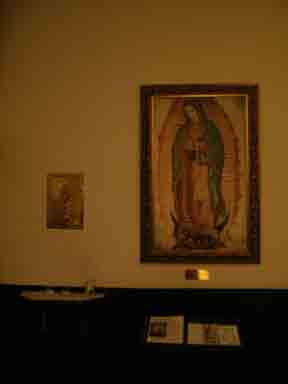Our Lady of Guadalupe The story In 1531 the native people of Latin America were near despair. Invaders from Spain had stripped them of their land, their religious traditions and their freedom. In 1531 the native people of Latin America were near despair. Invaders from Spain had stripped them of their land, their religious traditions and their freedom.
Before dawn on a chilly Advent morning, an Aztec farm worker named Juan Diego was walking to Mass. As he passed a hill called Tepeyac, a hill ancient and sacred to this people, he heard the songs of many kinds of birds. Coming closer, he beheld a woman radiating light, so that even the boulders and weeds of the hillside sparkled. Speaking in his own language, Nahuatl, she told him that she was the Virgin, the Mother of the True God. She asked that the people build a church on that very spot. She promised d would hear the cries of the poor and the oppressed. “Build me a home,” was her request. Then she asked Juan to take this message to the Spanish bishop of the diocese.
Juan Diego went to the bishop in Mexico City, but Bishop Fray Juan de Zumarraga did not believe him. On December 12, the Virgin provided Juan with proof no one could question. She directed him to the top of the frozen hill, where he marveled to find an abundance of fragrant roses growing amid the rocks and the brambles. She arranged an armful of blooms in his tilma (cloak), and he carried them off to the bishop. When he unfolded the tilma to display the roses, her magnificent image was found imprinted on it. Everyone who saw the image knew that Juan Diego had spoken truly. In the meantime, his uncle Juan Bernadino, gravely ill with smallpox, had been healed. The Virgin was already keeping her promise of help and consolation! The church was built without delay and people have streamed to it ever since.
The ImageThe image imprinted on the tilma is that of a young Nahuatl Indian shining with the light of the sun and with her feet upon the crescent moon. Her head is covered with the colour of the sky and the stars of the heavens. Her dress is the colour of the earth. The angel grasps in one hand the sky cloak and in the other, the earth dress. Heaven and earth meet. Her hands are in apposition of prayer. She is a messenger of the One God, not God’s self. She is pregnant, the sign of hope and new life. This is evidenced by the black belt worn by Nahuatl women to show they are pregnant, and by the glyph above the belt which proclaims birth. Guadalupe stands in solidarity with the women of the “new World” who had often been treated with violence by the conquistadors. Her NameBecause of a shrine back in their native country, Spaniards called her Our Lady of Guadalupe. She is also named La Guadalupina or La Morenita (the little dark one) del Tepeyac. Her image suggests she is patron saint of all America from Canada to Tierra del Fuego. She is also called Empress or Mother of the Americas.
Prayer
God of power and mercy, you blessed the Americas at Tepayac with the presence of the Virgin Mary of Guadalupe. May her prayers help all men and women to accept each other as brothers and sisters. Through your justice present in our hearts may your peace reign in the world. We ask this through Christ our Lord. Amen. MeditationWhere is the home I build for this word of reconciliation and peace?
How may I unite heaven and earth in my heart and in my life?
Deliver an unexpected rose to someone who is in need. Why the Image at Christ ChurchTraveling in Mexico Father Greg became familiar with her story. The message of Guadalupe seemed to speak so clearly in affirmation of the hopes and theological vision of this community. It seemed so clearly also a call to the faithful of the Americas and the home we have been invited to build for the world – places where the hatreds and prejudices of the old world could be left behind. There were few feminine images present in the decoration of the church. This seemed to be one that was asking to be a part of us. Eventually she presented herself. The plaque of dedication reads:
This image of Our Lady of Guadalupe, Patron of the Americas,
comes from Guadalajara, Jalisco, Mexico.
May her story and prayers further the work of inclusion,
peace and reconciliation
in the life of Christ Church, London,
and in the whole world.
Autumn 1998 “No olvides para siempre
la suerte de tus pobres.” |